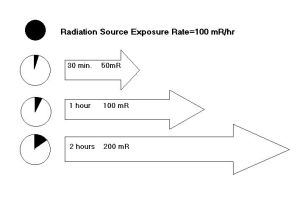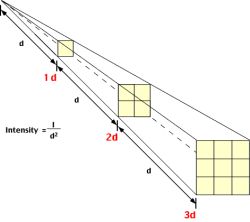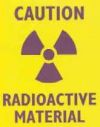| Page 2 |

|
|
1 - Radiation Safety
2 - Page 2 3 - Page 3 4 - Page 4 5 - Page 5 6 - Page 6 |

 HOME
HOME(First Thing First)
NRC Regulations
10 CRF 19
- Requirements for instruction of personnel
- Post of Notices and inspections
10 CRF 20
- Standards for radiation protection
Form NRC-3 "Notice to Employees"
- Posted in or near all radioactive materials use labs
- Lists responsibilities of NRC licensees and persons working wtih radioactie material
- Provides the address and phone number to contact the NRC
Dose Limits
Federal, state and Universtiy regulations limit the amount of radiation dose allowed to adult and minor radiation workers, members of the public, and the fetus of a declared pregnant radiation worker due to USPSNL operations
Maximum Dose Limit | ||
Adult Occupational Limit | 5000 mrem (5.0 rem)/ year | |
Minor Occupational Limit | 500 mrem (0.5 rem)/ year | |
Member of the Public | 100 mrem (0.1 rem)/ year | |
Declared Pregnant Radiation Worker's Fetus | 500 mrem (0.5 rem)/ pregnancy term | |
Declared Pregnant Worker
- It is important to note that a woman is considered pregnant (for NRC licence purposes) only if she declares herself so, in writing, to the radiation safety officer
- A woman may declare or undeclare her pregnancy at any time; it must be in writing to the Radiation Safety Officer
Things you should know...
- Licensed radioactive material may only be used by, or under the direct supervision of, individuals approved by the Research Leaders.
- Licensed radioactive material may not be used in tracer studies involving direct release of licensed material to the environment.
- Radioactive maerial may not be administered to humans or be added to food, beverage, cosmetic, drug or any other product designed for ingesting or inhalation by, or application to, humans.
- After removing the radioactive material, all radioactive marking on the package must be removed or defaced prior to placing the package for disposal or recycling
 |
![]() Radionuclides in Quicktime
Radionuclides in Quicktime
RunningTime: 10 minutes
Radiation Safety
ALARA = As Low As Reasonably Achievable
The primary goals of radiation safety are to avoid any unnecessary radiation exposure and to keep all exposure As Low As is Reasonably Achievable . While the USDA has a responsibility as an employer to provide a safe work environment, the primary responsibility for keeping an individual's radiation ALARA rests with that individual. ALARA can be accomplished by taking steps to minimize external and internal exposure. Three main ways to keep your doses ALARA: time, distance, and shielding
P.S. Obtaining higher doses is order to get an experiment done quicker is NOT "reasonable"Control/Minimization of Exposure through Time, Distance, and Shielding
  |
Time - Decreasing exposure time decrease the radiation dose proportionately. Radioactive materials which are capable of generating external dose rates should not be left unshielded any longer than is necessary
Distance - Increasing the distance from a source of radiation is frequently the most effective and economical means to reduce radiation dose. The radiation dose rate varies with the inverse square of the distance from the source. For this reason, remote handling devices such as tongs or tweezers should be used when handling significant quantities of radioactive materials.
- Doubling distance from source, decrease dose by factor of four
- Tripling it decrease dose nine-fold
Shielding = Shielding a source of radiation generally reduces the radiation levels for those working in the vicinity.
- Alpha emitting radionuclides - not an external hazard.
- Beta emitting radionuclides - best shielded by low atomic number absorbers such as Plexiglas. 1/4 inch of Plexiglas is adequate to shield even the high-energy beta particles emitted by P32
- Gamma emitting radionuclides - best shielded by high atomic number and high density materials, such as lead.
- Neutron emmitting radionuclides/sources - best shielded by low atomic number (hydrogenous) materials, such as water, paraffin, wax, plastic, or concrete
Know Your Radionuclides
Time, distance, and shielding is obviously not applicable when the radioactive material is already inside the body. The four routes by which radioactive materials can be taken into the body are:
- Inhalation
- Ingestion
- Absorption through the skin
- Injection through wounds
Phosphorus32 emits beta particles that can travel up to 20 feet in the air. Aside from ingestion, its principle hazard is exposure to skin and eyes.
The beta emission of sulfur35 and phosphorus33 is low energy. Ingestion is the principle hazard.
Iodine125 is a gamma and x-ray emitter. In its unbound form it presents an inhalation hazard and cna be a source for whole body exposure.
To protect agains these routes of intakes, the following laboratory safety rules are established:
No Smoking, Eating or Drinking in Laboratories - To minimize the risk of intake of radioactive materials by injestion, all forms of consumption in the laboratory or room in which radioactive materials are used or stored is prohibited.
Personal Protective Equipment must be worn when radioactive material is in use. These includes:
- Gloves
- Lab coat
- Long pants
- Closed-toe shoes
Laboratory surface/Surface covering. The proper working surface and/or surface covering will enhance your ability to control and remove contamination in the work area. These include the use of non-porous surfaces on floors and work areas:
- Stainless steel
- Plastic
- Linoleum
- Paint for porous cement floor
Lab benches should be lined with a protecitve covering to absorb spills and make decontamination easier. Poly-backed lab paper or diaper paper is used to control contamination and prevent spilled liquid from reaching the benchtop, where it may be more difficult to remove
For large quantity of radioactive liquid, use a spill tray beneath liquid waste containers for spillage or breakage.
If material is being tranferred from one work area or room to another, a sturdy container and/or a spill tray should be used
Avoid spreading contamination. Consider using aersol-resistant pipette tips to avoid contaminating your pipetting aid. The use of screw top Eppendork tubes prevents popping during heating and provides containment during centrifugation. Do not touch telephones, light switches, faucet handles, or doorknobs with gloved hands.
Look for contamination. Survey personnel and laboratory work area frequently using the appropriate survey method. Post-operational and routine contamination surveys of work areas and laboratory must be performed, and don't forget the centrifuge. And, always monitor your hands, shoes, and clothing when you complete your protocol
Ventilation Controls - A fume hood which is suitable for use of radioactive materials must be used when using volatile radioactive compounds such as I125, I131 as NaI sollution, tritiated water or powdered solids which are radioactive. In addition, nonvolatile compounds which are heaated, agitated, powdered, or otherwise treated in the lab is a manner which could cause them to become airborne shall be performed in the fume hood.
Note: No permittee may use more than 10 mCi of radioactive iodines at any one time in any fume hood without either charcoal filtration on the hood exhaust or LRPO approval
Rules for Fume Hood Use
- Fume hoods should be lined with absorbent paper
- Fume hoods should remain uncluttered
- Work should be performed at least several inches inside the sash
- Equipment and other materials should be placed a minimum of several inches behind the sash opening
- The sash should be brought down to the minimum height while still allowing adequate room to work safely
- The only time the fume hood should be fully open is during equipment setup
- All equipment should be raised above the floor of the hood by at least several inches to allow unrestricted airflow
- Equipment and other materials should not be placed against the baffles at the back of the fume hood.
- Avoid rapid movements withing the hood that might disrupt airflow
- When the hood is not in use, the sash should be kept closed
- Paper and other materials should not be allowed to be drawn into the duct work and the exhaust fan.
- Do not rely of the fume hood to protect you from splashes or spills
 |
Labeling work areas and containers of radioactive materials Radiological labels on the left are typically placed on radiation sources, source containers, or work areas where contamination may exist. Labels must bear the radiation symbol (magenta or black) on a yellow background and the words CAUTION (or DANGER) RADIOACTIVE MATERIALS.
Security. All radioactive materials, including stock solutions, waste, and experiments-in-progress, must be locked or attended to. This is to be enforced no matter how small the volume or activity. Security includes physical barriers such has locked boxes, locked refrigerators, and locked labs.
Lost or stolen radioactive material is a violation of the USDA license and permit requirements. Uncontrolled material can cause radiation exposure to the public and degrade both the functon and image of the USDA. Security over all forms of radioactive material is essential. Failure to maintain security may result in suspension or termination of the Radiation Use Permit
| << Previous 1 [2] 3 4 5 6 Next >> |
